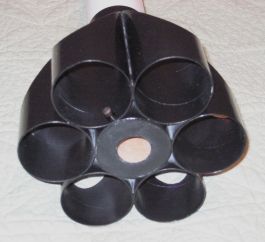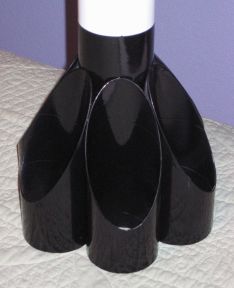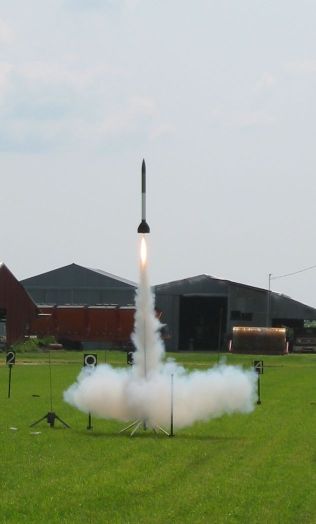Scratch Tube-a-licious Original Design / Scratch Built
Scratch - Tube-a-licious {Scratch}
Contributed by Lance Alligood
| Manufacturer: | Scratch |

Brief:
Tube-a-licious is a scratchbuilt tube fin rocket built with 2.6" paper
tubes. Other items of interest include tubes for the fins were cut at a 30
degree angle, a 29mm motor mount with foamboard centering rings, and zipperless
airframe design.
Construction:
I had been wanting to build an HPR with tube fins for quite a while but never
seemed to have enough tubing. I recently won several auctions on eBay for a
bunch of 2.6" tubes and couplers and 29mm tubes. The decision of what to
build for my first project with these newly won parts was simple!
Aside from a tube fin rocket, I wanted to incorporate several other techniques into the rocket that I previously had not used in any of my rockets to date: centering rings of alternate materials (in this case, foamboard), zipperless airframe with recovery system in the payload tube, and use of multiple adhesives in an HPR.
The build started with the main airframe. The 2.6" diameter tube came in 36" lengths so I cut one piece into 12" payload and 24" booster sections. The couplers I had were long--8 inches--and had a very snug fit so I was somewhat concerned with the ejection charge being unable to push that much tubing out. I opted to cut the coupler in half, sand it with 150 grit paper, followed by coating the unfinished paper with CA and sanding it with 320 grit sandpaper for a smooth fit. I found that to be more acceptable for use on this rocket.
Cutting the tubes was the fun part. I have enjoyed slotting my own tubes for TTW fins so there was no reluctance on my part to cut tubes. I wanted this rocket to really stand out so I thought of cutting the tubes at an angle like on the FlisKits Long Overdue (except without the nested tubes). Using Matt Stum's Template Widget (found on EMRR's Tool and Calculators page), I printed a 30 degree mitre template and cut out the paper wrap to trace the angled lines onto the tube. I prefer cutting (or slotting) tubes with a standard razor utility knife. The blade is sharper, stronger, cheaper, and lasts longer than X-Acto blades. Cutting is still done the same way though...several careful passes at a time.
 I marked the tubes
to indicate where the 6 tube fins should be attached along with the points on
the tube fins where they will touch. Starting with opposing tubes 1 and 4, I
used 12 minute epoxy (adhesive #2) with some milled fiber mixed in to attach
the tubes flush with the aft end of the main airframe tube. Once the first pair
had cured, I attached 2 and 3 to the main airframe, tube fin 1, tube fin 4, and
each other. Then I repeated the process with tube fins 5 and 6.
I marked the tubes
to indicate where the 6 tube fins should be attached along with the points on
the tube fins where they will touch. Starting with opposing tubes 1 and 4, I
used 12 minute epoxy (adhesive #2) with some milled fiber mixed in to attach
the tubes flush with the aft end of the main airframe tube. Once the first pair
had cured, I attached 2 and 3 to the main airframe, tube fin 1, tube fin 4, and
each other. Then I repeated the process with tube fins 5 and 6.
I am convinced that many of us overbuild our rockets and I wanted to make that statement with the motor mount. Instead of using plywood, I used foamboard. You heard me right! Foamboard is a key support material in Art Applewhite's 29mm Delta Saucer and Qubit, both of which I have built and flown successfully many, many times, so I figured I had gained enough real world use to put it into a more traditionally shaped rocket. I traced the necessary concentric circle on the foamboard and cut them out with a utility knife. They had an excellent fit that only required minimal sanding. Then I used a 6" piece of 29mm tubing for the motor mount tube. I used standard white glue to tack the rings onto the tube (one mounted flush with aft end and the other about 1/4" from the forward end) and then Gorilla Glue (polyurethane glue and adhesive #3) for fillets. After the Gorilla Glue foamed and cured, the rings strengthened considerably! When it came time to afix the MMT assembly into the main airframe, I mixed up more of the epoxy with milled fiber to assure that the motor mount stays right where I put it.
 Using foamboard
for the centering rings did keep me from using them as the point of attachment
for the recovery system. That was OK with me though because I had decided to
build it with a zipperless design. Using a piece of 1/4" birch plywood for
the bulkhead, I drilled a total of 9 holes, 8 to allow the ejection charge pass
through and one for the screw eye to attach the shock cord. The bulkhead was
glued and filleted to the coupler with aliphatic resin (yellow wood
glue--adhesive #4). Screw eyes were attached to the bulkhead and the base of
the LOC 2.6 nose cone with Gorilla Glue. The payload tube was attached to the
nose cone with a pair of lightweight 8-32 x 1/2" nylon screws. The shock
cord was borrowed from my Binder Design Dragonfly. It is a 12' long piece of
1/4" tubular nylon with 3 1/8" quicklinks attached (one for each end
and one for easy parachute attachment). With a 30" chute and both the
coupler and nosecone pushing their way into the payload tube, space is at a
premium so a heavier gauge shock cord might not fit...
Using foamboard
for the centering rings did keep me from using them as the point of attachment
for the recovery system. That was OK with me though because I had decided to
build it with a zipperless design. Using a piece of 1/4" birch plywood for
the bulkhead, I drilled a total of 9 holes, 8 to allow the ejection charge pass
through and one for the screw eye to attach the shock cord. The bulkhead was
glued and filleted to the coupler with aliphatic resin (yellow wood
glue--adhesive #4). Screw eyes were attached to the bulkhead and the base of
the LOC 2.6 nose cone with Gorilla Glue. The payload tube was attached to the
nose cone with a pair of lightweight 8-32 x 1/2" nylon screws. The shock
cord was borrowed from my Binder Design Dragonfly. It is a 12' long piece of
1/4" tubular nylon with 3 1/8" quicklinks attached (one for each end
and one for easy parachute attachment). With a 30" chute and both the
coupler and nosecone pushing their way into the payload tube, space is at a
premium so a heavier gauge shock cord might not fit...
The final step in the build was to install the rail buttons. I drilled 2 holes right along the center of one of the tube fins right into the airframe. This allowed that tube fin to wrap around the rail just making it that more trick when put on the rail.
Finishing:
Primed the entire rocket with Kilz first and then laid down all of the colors
with Krylon gloss spray paints. The Kilz was particularly helpful in getting a
relatively smooth surface on the inside of the tubes as the paper readily
absorbed the moisture of the paint, needing more sanding than what's typically
required to get a smooth finish. Painting the fins was a lot trickier than I
had thought it was going to be. It took quite a few light coats to get in all
of the nooks and crannies in and around the tube fins.
I knew I had accomplished my task when I got a lot of attention at the launch site. Compliments, questions, and (post-flight) congratulations came from just about everyone in attendance. Sweet!

Flight:
Boost was straight and faster than I'd expected with the AT G64-7W. I was even
more impressed by the overall altitude of this flight. It simmed to ~1250 and
with only an occasional gentle breeze at the launch site, I'd say that
Tube-a-licious was defintely in the ballpark of the simulated height. It's a
rocking motor-rocket combination regardless!
Tube fin rockets are not known for their speed shredding ability and Tube-a-licious is no exception, but what you might lose in overall velocity, you gain in a guaranteed stable flight. Future flights will be on Ellis Mountain single use G35s (I love that 4 second burn!) and eventually AT motors compatible with the 29/180 & 29/240 casings.
Recovery:
Ejection came with the nose cone just starting to point downward. Close enough
to perfect if you ask me... The Nomex heatshield did it's job wonderfully (my
first time using one) as the PML 30" chute borrowed from my PML Phobos
proved to be the right match for the weight of the rocket. It landed gently
within 100yds of the launch pad. Super flight and recovery!
Also with the use of the Nomex shield in place of "dog barf", I now have room to squeeze in my Rocket Beeper for use with higher thrust motors to aid in recovery. If I were to build a another Tube-a-licious though, I would make sure to have a larger payload/recovery bay (probably by making the airframe 2 18" sections instead of one 12" payload and one 24" booster).
Summary:
I set out with a number of personal goals in mind for this build and passed
with flying colors! This would be a great design for someone attempting their
Level 1 certification, however, cutting the tube fins, while not difficult, is
certainly timeconsuming, painstaking work so I wouldn't recommend this to
someone just getting into HPR. The time put into the build though, pays off
dividends as it makes for an attention getting rocket because of the angled
leading edge of the tube fins. It lends a more aggressive look while providing
a unique and super stable design.
Sponsored Ads
 |
 |











